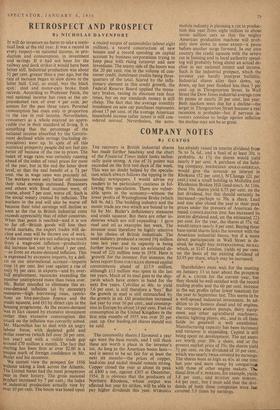COMPANY NOTES
By CUSTOS
THE recovery in British industrial shares has made further headway and the chart of the Financial Times index looks techni- cally quite strong. A rise of 33 points was recorded on the first two days of the week. This was no doubt helped by the specula- tion which always follows the tipping in the Sunday newspapers. I would advise my readers to be particularly cautious in fol- lowing this speculation. There are vulner- able spots in the economy—witness the lower profits of Westinghouse Brake (which fell 9s. 6d.). The building industry and the motor trade are two which are bound to be hit by Mr. Butler's deflationary measures and credit squeeze. But there are other in- dustries which are still expanding : I gave steel and oil as examples last week. The investor must therefore be highly selective in his choice of British industrials. The steel industry produced a record 19i million tons last year and its capacity is being further increased to meet an estimated de- mand of 223 million tons in 1958. Here is 'growth' for the investor. For instance, the latest report from COLVILLES showed capital commitments ahead of £13.9 million, although £13 million was spent in the last ten years. Much of its steel goes to the ship- yards which have orders in hand for the next five years. Colvilles at 40s. to yield 5.6 per cent. is still therefore a 'buy.' But the growth in steel is still outmatched by the growth in oil. Oil production increased last year by over 10 per cent., and consump- tion in Europe by about 14 per cent. Fuel oil consumption in the United Kingdom in the first nine months of 1955 was over 20 per cent. up. Our leadingioil shares should not be sold.
* * * The commodity shares I favoured a year ago were the base metals, and I still think these are worth a place in the investor's list. As long as the American boom lasts— and it seems' to be set fair for at least the next six months—the prices of copper, lead-zinc and nickel should remain strong. Copper closed the year at about its peak of £400 a ton, against £305 at December, 1954. It is obvious that the producers of Northern Rhodesia, whose output was affected last year by strikes, will be able to pay higher dividends this year. NeCHANGA
has already raised its interim dividend from 5s. to 7s. 6d., and a final of at least 20s. is probable. At 153 the shares would yield nearly 9 per cent. A purchase of the hold- ing company, RHODESIAN ANGLO-AMERICAN, would give the investor an interest in Rhokana (52 per cent.), N'Changa (21 per cent.) and a small holding in Mufulira and Rhodesian Broken Hill (lead-zinc). At 116s. these 10s. shares yield 6.55 per cent. on the last dividend, but this should certainly be increased—perhaps to 70s. a share. Lead and zinc also closed the year at their peak prices under the pressure of American de- mand. CONSOLIDATED ZINC has increased its interim dividend and, on the estimated 223 per cent. for the year, the shares at 57s. 6d. would return nearly 8 per cent. Buying these base-metal shares links the investor with the American industrial boom, but if a more direct participation in Wall Street is de- sired, he might buy INTERNATIONAL NICKEL which, at $147 London, yields 43 per cent. on the basis of the existing dividend of $3.95 per share, which may be increased.* Shareholders must wait for the meeting on January 13 to hear about the prospects Of R. A. LISTER for the current year, but they should be well satisfied with the record trading profits and the 60 per cent. increase in the net profits (after lower taxation) for the year to September last. This seems to be a well-spread industrial investment. In ad- dition to its famous diesel and bil engines, the company .makes pumps, dairy equip- ment and other agricultural machinery, electric lighting plants, etc., and in all these fields its goodwill is well established. Manufacturing capacity has been increased and turnover is expanding. Capital is still being spent on development. The net assets are worth over 30s. a share, and at the present market price of 35s. the shares yield 53 per cent. on the dividend of 10 per cent., which was nearly twice covered by earnings. The shares were as high as 41s. at one time last year and seem cheap by compariso with those of other engine makers. Tts. diesel firm of F. PERKINS, for example, yields 3.8 per cent., and RUSTON AND HORNBY, 4.6 per cent., but I must add that the divi- dends of both these companies were last covered 3.9 times by earnings.


































 Previous page
Previous page